What Can’t Be Buried: Unearthing Revival Field
At the former site of Mel Chin's landmark project in St. Paul: ecological grief, cycles of remediation, and what happens when we try to put waste out of sight

I don’t seek out images of burning forests or lakes retreating into themselves, but still they find me. When a video of a collapsing glacier punctures my feed, I scroll past—if my thumb moves quickly enough, then the ice might stay intact. That same reflex kicked in last month when the Intergovernmental Panel on Climate Change (IPCC) released their updated report on global warming. Though I could not bring myself to read the actual assessment, I pieced together its outline from overheard radio clips and highly-designed Instagram graphics: our current path of escalating instability is now fixed; many places will soon encounter their worst-case scenarios.1 Within hours, however, other horrors became top stories, burying the panel’s findings, churning them into another layer of sediment. For the moment, we were saved.
Climate researchers came up with the term “ecological grief” to explain our responses to experienced and anticipatory losses brought on by environmental destruction.2 I would like to be someone who devotes the appropriate time and attention to confronting their grief, but it’s a slippery thing, so I busy my hands instead.
I left the arts field last year and joined the Mississippi Park Connection, a group dedicated to restoring habitat along the Mississippi River. I tended to a number of climate adaptation projects, one of which involved a secluded test plot within Pig’s Eye Regional Park, a sprawling park wedged between St. Paul’s East Side neighborhood and the municipal airport. The plot contains bald cypress and tupelo trees, two species commonly found in the southeastern United States. Their planting in Minnesota is an attempt at modeling a future forest in an environment made warmer and wetter by climate change—a future where the bald cypress, the Louisiana bayou’s signature tree, might plant its knobby limbs at the opposite end of the Mississippi. The majority of trees died during their first winter, but a few dozen remain. Emerging anew each spring, the cypress’s feathery needles are a joy to brush against.
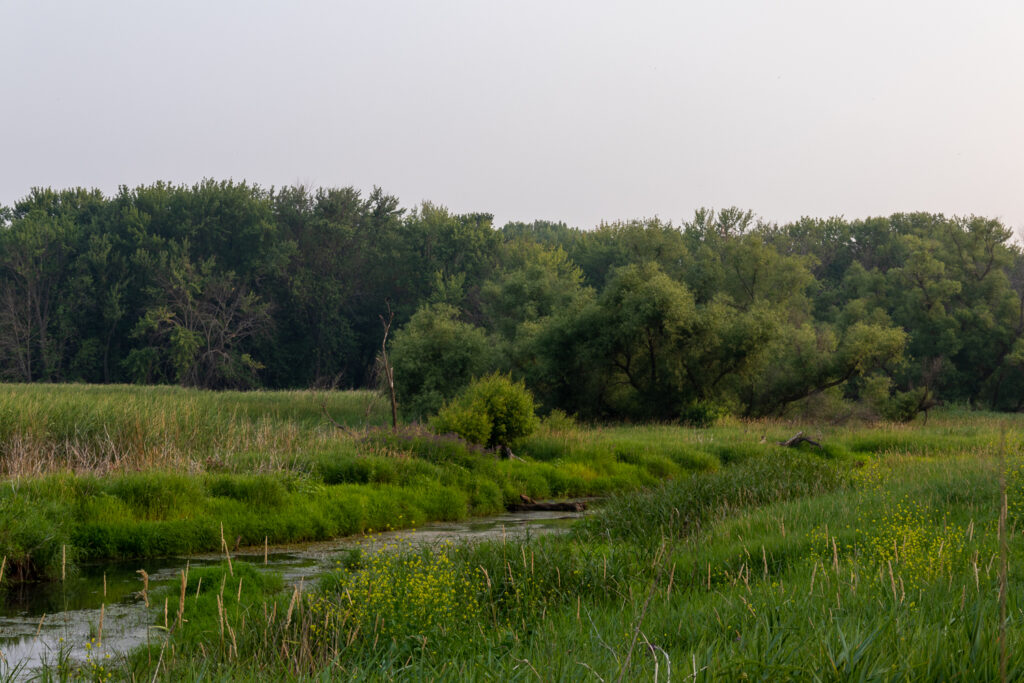
Known as Čhokáŋ Taŋka (the “big middle”) in Dakota, the land that now constitutes Pig’s Eye is part of a larger stretch of sacred sites for Indigenous peoples. Kaposia, a seasonal Dakota village, was situated next to Pig’s Eye Lake, which makes up the southern end of the present park. Atop the limestone bluffs that form the northern edge is Indian Mounds Regional Park, comprised of burial grounds that have been occupied for thousands of years. At the bottom of those bluffs sits Wakáŋ Tipi, a cave where honored spirits dwell.3
In 1851, the federal government forced the Dakota to sign the Treaty of Traverse des Sioux and the Treaty of Mendota, which together ceded 24 million acres to white colonizers, displacing long-time settlements like Kaposia.4 Ever since, Čhokáŋ Taŋka has become a state-sponsored “sacrifice zone,” writes the Environmental Justice Team at the Lower Phalen Creek Project (LPCP), an Indigenous-led conservation organization currently building an interpretive center by Wakáŋ Tipi. In the late 19th century, the Milwaukee Road railroad dynamited the aforementioned bluffs to lay new tracks, destroying a chamber of Wakáŋ Tipi and several mounds; where 37 mounds once stood, only six remain today. Then, between 1956 and 1972, a 230-acre section of Pig’s Eye served as an unregulated landfill, and later as a disposal site for incinerated sewage sludge produced by the neighboring Metropolitan Wastewater Treatment Plant. By the time cleanup efforts began in 1989—the year Pig’s Eye was designated a state Superfund site—8.3 million cubic yards of waste covered the area.5
Conventional remediation methods have proven impossible here. Pig’s Eye is situated in a floodplain, a constantly transforming ecosystem subject to the Mississippi River’s variable flooding. Most of the waste is submerged below the water table, so traditional landfill covers are effectively useless; the “forever chemicals” that 3M dumped decades ago when developing Scotchgard and Teflon will forever mix with the Mississippi’s backwaters. The absolute removal of this waste was estimated at $730 million—a sum that makes lawmakers scoff. Even if the waste were to be removed, an alternative dumping ground would need to be identified, another land occupied.
In what seemed like an expression of their own exasperation, officials decided to bury the entire landfill in two feet of fill dirt. This additional material slowed pollution discharge, ensuring only an acceptable level of toxins could reach the river. It was the perfect solution: what could once be buried could be reburied, until we built a barrier so thick that we wouldn’t have to think about this place again.
I ventured to Pig’s Eye on a hot June morning with Tom Bierlein, a sculptor and gardener. I had visited the park a handful of times, but made a wrong turn and drove the length of a massive gravel pit before I realized my mistake. Though it’s St. Paul’s largest park, Pig’s Eye is also its most difficult to access. After exiting I-94 just beyond downtown, you loop around a concrete production facility, then turn down a narrow outlet road that traces along the railyard; dust kicks up from passing semi-trucks with operators who look upon you from their cabs, wondering why your little sedan is puttering through a land reserved for heavy machinery. Mountains of chipped wood mark the next turnoff. A dirt road that curves around a pile of broken-down pallets before ending at a heap of excavated rock next to a turnaround: the park’s informal entrance.
Here we met Aaron Dysart, an artist who speaks of Pig’s Eye with the enthusiasm of a park ranger admiring the Grand Canyon at sunrise. Before we began to meander through the park’s tall grasses, we wrapped our pants with duct tape and doused any exposed skin in DEET, a necessary ritual during warmer months because, as Aaron reminded us, “Pig’s Eye has all the ticks—like, all of them.” While I wanted to show Aaron and Tom the test plot, we were also looking for a different experiment: Mel Chin’s Revival Field.
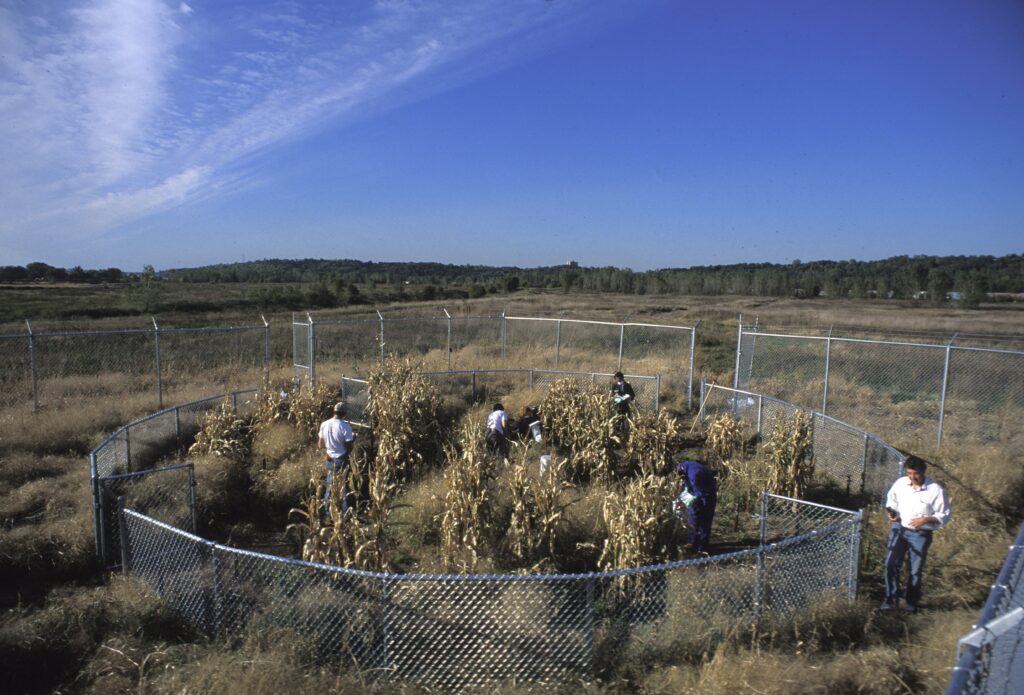
Mel Chin’s Revival Field, 1991, Pig’s Eye Landfill, near St. Paul, Minnesota. Courtesy Walker Art Center Library and Archives. 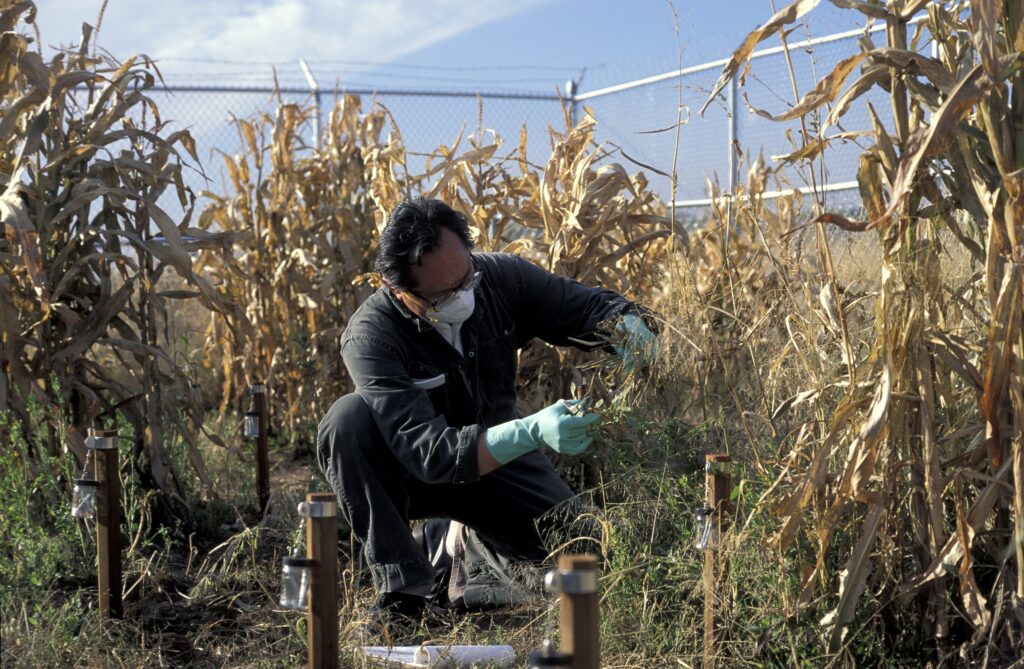
Mel Chin’s Revival Field, 1991, Pig’s Eye Landfill, near St. Paul, Minnesota. Courtesy Walker Art Center Library and Archives. 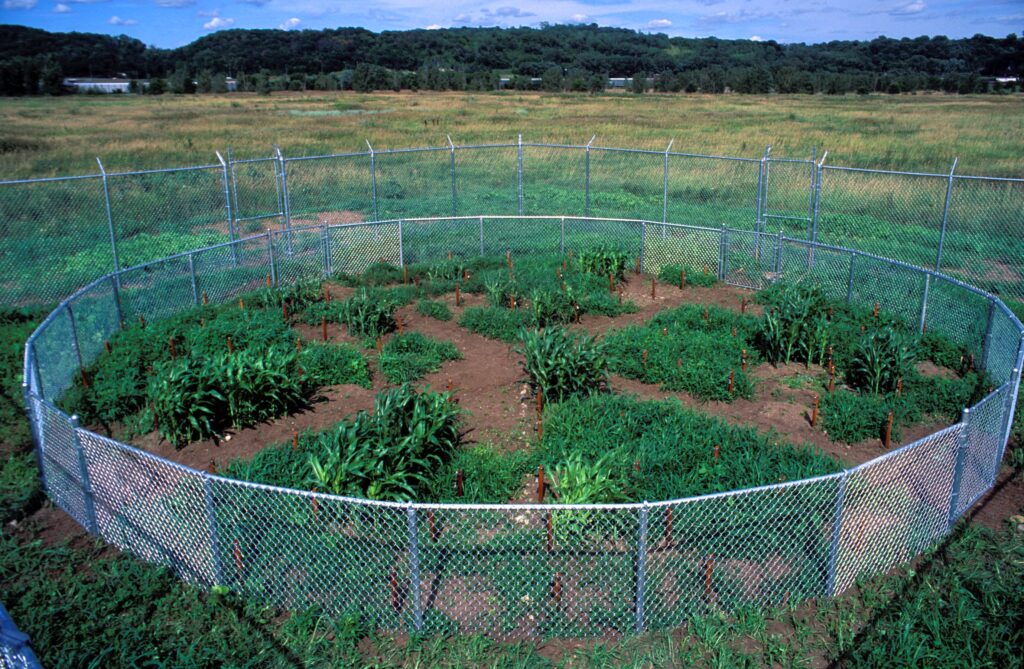
Mel Chin’s Revival Field, 1991, Pig’s Eye Landfill, near St. Paul, Minnesota. Courtesy Walker Art Center Library and Archives.
Throughout his decades-long practice, Chin, a Houston-born multidisciplinary artist, has shifted between critiques of authoritarian regimes abroad and atrocities committed closer to home. Another line running through his oeuvre is an interest in using art to rehabilitate and remediate: an abandoned home in Detroit transformed into a community-owned worm farm, a mobile art project addressing childhood lead poisoning in post-Katrina New Orleans. His longstanding interest in the afterlife of broken and unseen things led him directly to Pig’s Eye.
Revival Field was built atop layers of waste and profoundly degraded soil in 1991 with the intention of removing heavy metals from the ground.6 Chin partnered with Dr. Rufus Chaney, a soil remediation expert with the U.S. Department of Agriculture, to design the garden, which they stocked with “hyperaccumulators”—plants like maize and red fescue grass with roots able to absorb cadmium, zinc, and lead, storing particulates in their tissue; when burned in reclaiming furnaces, mature plants generate metal purer than mined ore. The plants were harvested for three successive years and shipped to Dr. Chaney’s lab, where researchers determined that alpine pennycress, a low-lying member of the cabbage family, had the capacity to restore soils in as little as four years. Chin and Dr. Chaney’s findings supported then still-emerging theories around phytoremediation, a now readily accepted means of utilizing plants to stabilize and extract contaminants within soil and groundwater.
As Aaron, Tom, and I wandered along the overgrown trail that twists through the park, I held the naive hope that we would stumble upon a leftover stretch of chain link fence or a remnant pennycress patch thriving in its adopted habitat. But no vestiges remain. At the time of Revival Field’s installation, the city banned public entry to the site due to potential toxin exposure. To deter visitors, the structure was dismantled in 1993, its surviving plants burned. A few years later, the entire landscape was again buried in more fill soil, making its contours unrecognizable; Aaron mentioned that even Chin had trouble locating the original site when he returned in 2017.
When we arrived back at the dirt turnaround and started plucking the ticks that had burrowed into our socks, crushing them with loose gravel, I found myself at a loss for words. In a later conversation, Aaron shared the same sentiment: “The issues at Pig’s Eye feel a bit overwhelming in many ways. The scale feels rationally huge, but somehow experientially larger than thought can dictate.” Aaron has spent more time at Pig’s Eye than most. When I followed the makeshift trail he weaved through the prairie—tripping on exposed roots; keeping my eyes to the ground to avoid stepping on garter snakes—I began to sense the extraordinary weight of the space. The park is not a metaphor, but a pulsating, physical manifestation of historical and contemporary failures stacked atop one another—a confluence of violence that courses through the Mississippi River Basin’s entirety without finding a drainage channel.
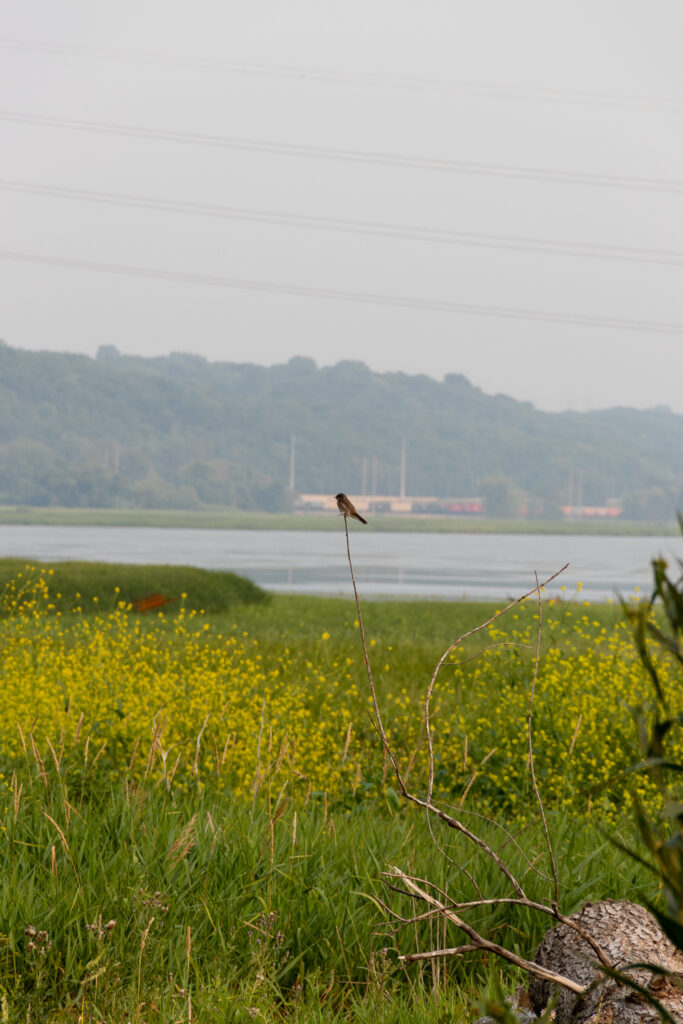
That a bald cypress should take root amongst this mess feels like a small miracle. But in fact, Pig’s Eye is teeming with life. Though the Minnesota Pollution Control Agency (MPCA) has restored certain hotspots over the past two decades—planting trees to stabilize Battle Creek, which runs through the park; adding dredged sand to the lakeshore to limit erosion—much of the landscape has regenerated naturally. In addition to slowing contaminant leaching, the layers of added soil also introduced organic material to an ecosystem stripped of nutrients. Today, monarch butterflies flutter around a blooming prairie that dips into a dense stand of cottonwood trees. Just south of the lake sits one of the largest rookeries in the region, where hundreds of herons, egrets, and cormorants nest.
In her book The Mushroom at the End of the World, anthropologist Anna Tsing contemplates matsutake mushrooms, which flourish in human-disturbed environments such as the scarred scrublands left behind after clear-cutting in the Pacific Northwest. “Global landscapes today are strewn with this kind of ruin,” Tsing writes. “Still, these places can be lively despite the announcements of their death.”7 Though we often think about habitat restoration as something that humans might do to an ecosystem—the cypress plot being one example—Tsing draws our attention to the abilities of non-human species to create livable conditions: underground fungal networks transporting nutrients across stressed forest floors; beavers within the Chernobyl Exclusion Zone returning deserted industrial land to bogs. Back in our own ruin, cottonwoods provide rare shade at Pig’s Eye, and local bees use the tree’s resin to strengthen their hives.
It is difficult to linger here, atop a landfill roughly three times the area of the Mall of America, and not find yourself in awe of nature’s capacity to persist. But, like dolphins gliding through Venice’s Grand Canal, this too is a mirage. Observation wells dot the landscape, which the MPCA use to monitor groundwater contamination. Now weathered and rusted, the wells conjure up the site’s past, and all that festers just below the surface.

Since the forced relocation of Kaposia, this land has never been allowed reprieve. On a subsequent trip with photographer Bade Turgut, haze from wildfires raging just across the Canadian border blanketed the park. The smell of further-away forests burning reminded me of accounts from local residents who remembered the landfill smoldering from 1956 to 1964, and again for two straight months in 1988.8 During the brief time of this writing, two accidents occurred at the railyard (now operated by Canadian Pacific Railway.) In August, three trains collided and 1,200 gallons of diesel fuel spilled near Wakáŋ Tipi; in July, more than 700 gallons of diesel poured into Battle Creek. The public would not have known about the latter spill if not for community activists who spotted the cleanup gear drifting in the freshly oil-slicked creek; Canadian Pacific never notified the city.9
This land’s desecration is also immaterial: The park’s very name originates from the first white settler within the present-day boundaries of St. Paul—a one-eyed, French-Canadian fur trapper named Pierre “Pig’s Eye” Parrant, who set up a bootlegging operation close by. Besides the name, the constant, screeching sounds of train tracks switching and engines braking fill the air. All the pennycress in the world might absorb the remaining cadmium, but could never pull that underscoring, spectral sound from the wind.
The particular ways history repeats at Pig’s Eye make me wonder whether humans should have a footprint here at all—but our presence is exactly what LPCP envisions. “People rarely visit due to inaccessibility,” the Environmental Justice Team wrote to me. “It will always be difficult to restore the land without people visiting, appreciating, and wanting to give back.” For LPCP, a yet-to-be-realized remediation step involves improving transit access through the industrial maze and incorporating signage that centers Dakota narratives, reminding visitors that, despite becoming a sacrifice zone, the area was never truly anonymous. That vision is shared by St. Paul’s Great River Passage Initiative, which aims to create public connectivity throughout the East Side River District. Angie Tillges, the Great River Passage Fellow, confirmed a forthcoming project that would promote access to Pig’s Eye Lake.
While these plans await funding, it’s worth considering the people already moving about this landscape every day—not park visitors, but those semi-truck operators. If you flush a toilet anywhere in the Twin Cities, the flow ends at the Metropolitan Wastewater Treatment Plant, one of the largest such facilities in the nation, servicing 1.8 million residents. Through a multi-tiered system of screens, scrapers, and tanks of nutrient-eating microorganisms, the plant discharges water back into the Mississippi cleaner than the river it mixes with. 300 employees work in round-the-clock shifts to ensure the cycle continues without disruption, making the cities inhabitable for the rest of us.10 On the opposite side of Pig’s Eye Lake Road, the mountains of chipped wood at Environmental Wood Recycling will soon be hauled and converted to biomass at District Energy in St. Paul, where it will heat the underground water pipes that snake through downtown.11 The number of trees the facility processes each year—260,000 tons in 2019—has rapidly increased due to the emerald ash borer, a beetle introduced to the Midwest in 2002 that has aggressively chewed through forests ever since. In the coming years, Minnesota is projected to lose one billion ash trees alone; its near-extinction poses an existential threat to the surrounding floodplain. And yet, from Pig’s Eye, irreparable loss heats the capital.
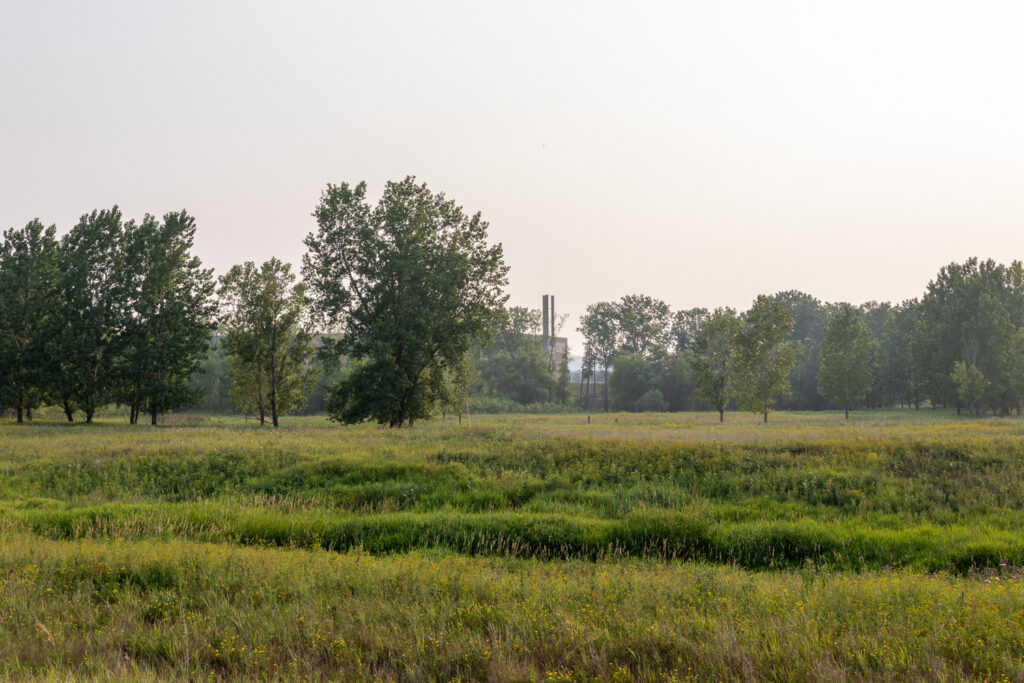
Both facilities reverse the landfill logic that has long permeated Pig’s Eye, contending with our waste in plain view instead of burying it elsewhere. In this respect, they are reminiscent of Revival Field. Chin recognized that, in order to address an obscured problem, he would first need to isolate and unearth it. He arranged the installation’s fencing in the shape of a crosshair target, bringing intention and specificity towards a place that officials had given up on. He attempted to move Pig’s Eye from the city’s periphery to its center and, in so doing, call attention to the institutions responsible for its ruin. But it too was buried.
After his initial installation at Pig’s Eye, Chin went on to install more iterations of Revival Field upon toxic sites in Florida, the Netherlands, and Germany. But back in Minnesota, the land seems suspended in time. Meanwhile, at the Mississippi’s headwaters, a Canadian oil company continues to drive a pipeline through Indigenous territory to the silence of both the Biden and Walz administrations.12 Thirty years after Revival Field’s inception, we have been compelled to fight on more fronts while the collective challenges we confront only feel more insurmountable.
But there is something undeniable about walking the grounds at Pig’s Eye. Observing both the workers and the non-human worldmakers navigating this ruin lends a physical language through which we might be able to speak of ecological catastrophe in all of its liveliness, and work through our present and future grief. We never stumbled upon the specific site where Revival Field once stood, but its burial reminds us that remediation is both an impossible project, and one we must take on anyway.